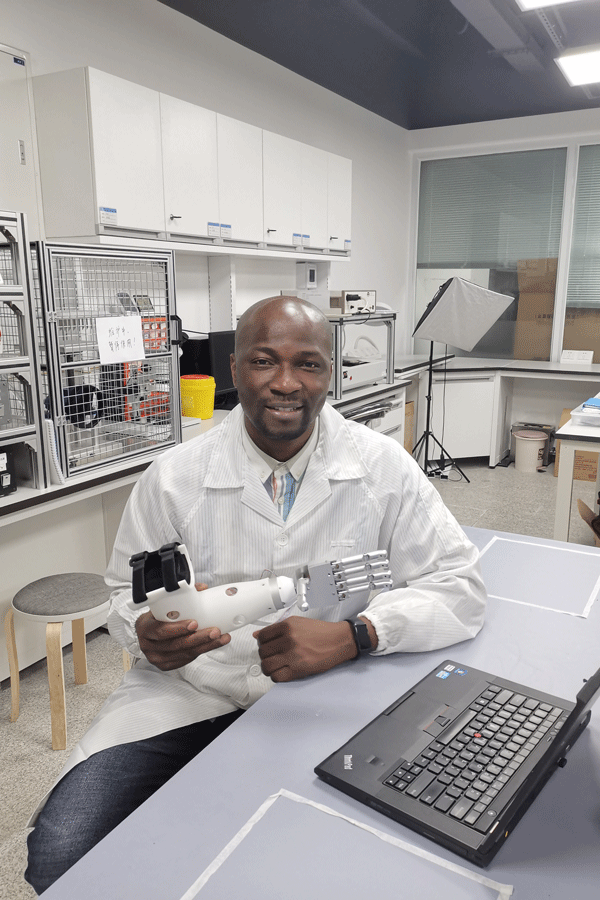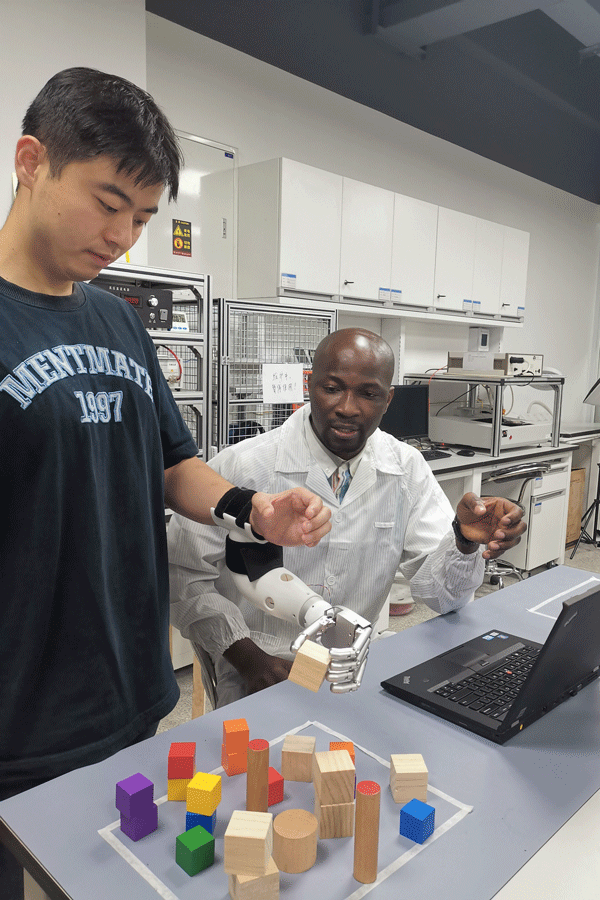Amputees often experience the feeling of a painful 'phantom limb', and believe they cannot move the remaining stump anymore. Needless to say that the loss of a limb severely impairs everyday life.
Nigerian scientist Oluwarotimi Samuel, an Associate Professor of robotics and intelligent systems with the Center for Neural Engineering at the Shenzhen Institute of Advanced Technology of the Chinese Academy of Sciences (CAS), is working to find a solution to amputees who lost their arm.
"I always wished I could make sizable contributions to scientific research and technological innovation, particularly in the field of artificial intelligence (AI) and its application in health care," said Samuel.
"This is why, my gratitude goes to the very first incentive I received, CAS-TWAS President’s Fellowship, in 2014, which allowed me to engage fully in scientific research and obtain my PhD in pattern recognition and intelligent systems (2014–2017) under the supervision of Prof. Li Guanglin, from the University of Chinese Academy of Science, in Beijing. This was one of the very first important steps that brought me where I am today."
CAS-TWAS President’s Fellowship was launched in 2013, sealing a long-standing collaboration between the two academies, a partnership dating back to 2004. A new scholarship programme was then drafted in 2019 by the two institutions and became officially effective in April of this year, with the inclusion of the Alliance of International Science Organizations.
TWAS and CAS are also joining forces, in collaboration with the China Association for Science and Technology, in organizing TWAS Sixteenth General Conference that will take place from 21 to 24 November and will be hosted by Zhejiang University.
Paving new rehab avenues
From being awarded the CAS-TWAS President’s Fellowship to receiving the 2022 Personality of the Year Award from Pride of Africa Awards to being listed among the "2022 Top 2% most cited scientists" by the prestigious Stanford University seems a short step, which obviously is not.
Samuel earned a BSc in 2009 with first-class honours from Kogi State University, and an MTech in 2014 with distinction from the Federal University of Technology, Akure—both in Nigeria and both in computer science. His master’s research focused on developing intelligent systems that could enhance the accuracy and speed of medical diagnoses.
 During his PhD, he specialized in developing AI-driven technologies. Now, as an Associate Professor at the CAS-Shenzhen Institute of Advanced Technology, he is focusing on upper limb rehabilitation strategies, a field where his promising results may have a lasting impact also on human-machine interfaces.
During his PhD, he specialized in developing AI-driven technologies. Now, as an Associate Professor at the CAS-Shenzhen Institute of Advanced Technology, he is focusing on upper limb rehabilitation strategies, a field where his promising results may have a lasting impact also on human-machine interfaces.
"I developed an efficient technique that allows the characterization of multiple patterns of limb movement intents in post-stroke patients, which could spur various potential advancements in the field," said Samuel.
His outstanding academic achievements and voluntary knowledge-exchange activities led to the bestowing of the 2022 Personality of the Year Award from Pride of Africa Awards, an initiative established in 2013 to acknowledge Africans' achievements in various fields, including sciences.
"My specific focus, now, is to study the biomechanics of upper extremity movement patterns from acquired bio-signals, to understand how best the underlying motor intent could be decoded via computer algorithms, which would be beneficial for advancing upper limb rehabilitation technologies,” he explained.
Not an easy task: Developing rehabilitation robots—prosthesis—requires careful consideration of the characteristics of amputees’ residual limb muscles and their status, in order to understand if they are able to generate some myoelectric signals or not.
"When asked to perform certain limb movements such as raising an arm, some amputees would say 'I can’t do it', even when the muscles are there," Samuel explained.
With his SIAT-CAS group, therefore, he designs prosthetic sockets that fit perfectly the amputee's stump. Then they place miniaturized sensors inside the socket, corresponding to specific locations of the residual muscles to record biological signals.
"This is when we integrate a control algorithm in the prosthesis microcontroller that receives the signals, decodes the movement, and moves the device accordingly, enabling the amputees to perform the intended task," he said.
Findings from his studies may offer new avenues in related areas, such as intelligently driven wheelchairs, human-computer interaction systems, and applications that require recognition of myoelectric signals.
With such a potential impact on many aspects of life, it's not surprising that Samuel was also listed among the "2022 Top 2% most cited scientists" by Stanford University.
Cristina Serra

